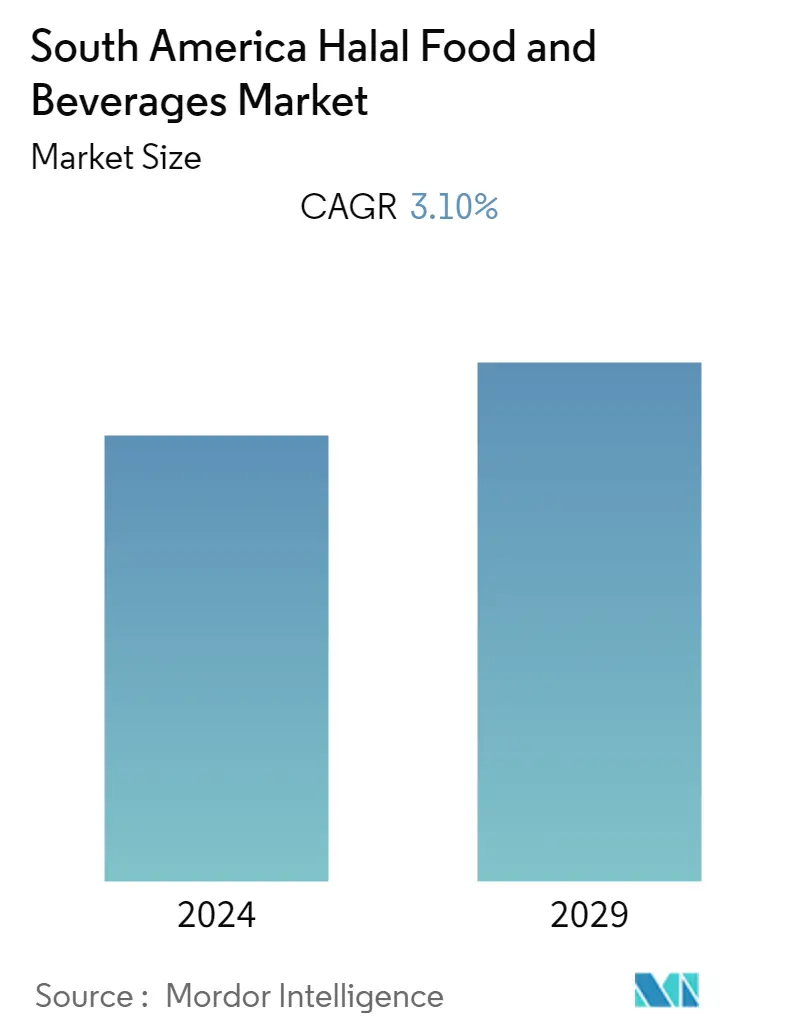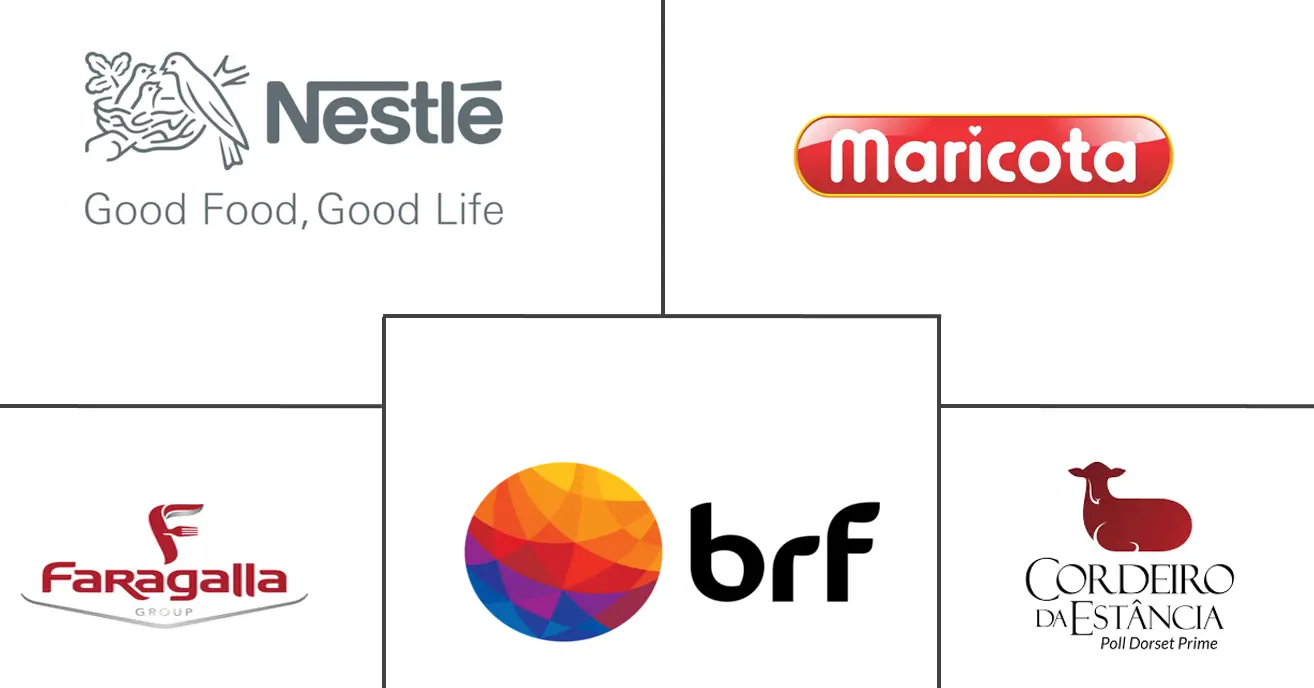Market Size of South America Halal Food & Beverages Industry

| Study Period | 2019 - 2029 |
| Base Year For Estimation | 2023 |
| Forecast Data Period | 2024 - 2029 |
| Historical Data Period | 2019 - 2022 |
| CAGR | 3.10 % |
| Market Concentration | High |
Major Players
*Disclaimer: Major Players sorted in no particular order |
South America Halal Food & Beverages Market Analysis
The South American market for halal food and beverages is projected to register a CAGR of 3.1% during the forecast period (2020 to 2025).
- The demand for halal certification has been driving the South American halal products market. The rise of the request for halal products is due to the new trend followed by consumers such that the halal certification helps in meeting the increased need for quality assurance, where food security issues are being faced by a lot of countries in this region, thus, driving the demand for the South American halal food.
- In emerging economies, such as Brazil, there has been an increasing interest in the consumption of organic and natural food products, which represents a strong adjacent market for halal food products to address. Halal food companies in South America have also been focusing on expanding its offering by developing flavors that suit a particular South American country cuisine, thus, increasing its reach in the other Latin American countries.
South America Halal Food & Beverages Industry Segmentation
The South American market for halal food and beverages is segmented by product type that includes halal food, halal beverages, and halal supplements. The halal food section is further divided into meat, processed meat, and other products. Based on the distribution channel, the market is segmented into hypermarket/supermarket, specialty stores, convenience stores, and other distribution channels. The study also involves the analysis of regions, such as Brazil, Argentina, and Rest of South America.
| By Type | |||||
| |||||
| Halal Beverage | |||||
| Halal Supplements |
| By Distribution Channel | |
| Hypermarket/ Supermarket | |
| Specialty Stores | |
| Convenience Stores | |
| Other Distribution Channels |
| Geography | |||||
|
South America Halal Food & Beverages Market Size Summary
The South American halal food and beverages market is experiencing a notable expansion, driven by an increasing demand for halal certification. This trend is largely attributed to consumers seeking quality assurance in their food products, particularly in regions facing food security challenges. The market is further bolstered by the growing interest in organic and natural food products, especially in emerging economies like Brazil. Halal food companies are capitalizing on this trend by diversifying their offerings to include flavors that resonate with local cuisines, thereby extending their reach across Latin America. The availability of halal products in Western-style grocery stores, such as supermarkets and hypermarkets, is also contributing to the market's growth, as these outlets cater to both Muslim and non-Muslim consumers seeking high-quality and hygienic food options.
Brazil stands out as a significant player in the global halal market, being one of the largest exporters of halal-certified food products worldwide. The market's growth is supported by new entrants, established companies expanding internationally, and multinational corporations investing in Muslim-majority markets. The South American halal food and beverage sector is characterized by consolidation, with key players like BRF SA, Nestle SA, and Maricopa Alimentos actively engaging in strategies such as expansion, mergers, and acquisitions to meet the rising demand. As globalization continues to influence consumer preferences, the acceptance of halal-based foods and beverages is expected to increase, further driving the market's development during the forecast period.
South America Halal Food & Beverages Market Size - Table of Contents
-
1. MARKET DYNAMICS
-
1.1 Market Drivers
-
1.2 Market Restraints
-
1.3 Porter's Five Forces Analysis
-
1.3.1 Threat of New Entrants
-
1.3.2 Bargaining Power of Buyers/Consumers
-
1.3.3 Bargaining Power of Suppliers
-
1.3.4 Threat of Substitute Products
-
1.3.5 Intensity of Competitive Rivalry
-
-
-
2. MARKET SEGMENTATION
-
2.1 By Type
-
2.1.1 Halal Food
-
2.1.1.1 Halal Meat
-
2.1.1.2 Processed Meat
-
2.1.1.3 Other Products
-
-
2.1.2 Halal Beverage
-
2.1.3 Halal Supplements
-
-
2.2 By Distribution Channel
-
2.2.1 Hypermarket/ Supermarket
-
2.2.2 Specialty Stores
-
2.2.3 Convenience Stores
-
2.2.4 Other Distribution Channels
-
-
2.3 Geography
-
2.3.1 South America
-
2.3.1.1 Brazil
-
2.3.1.2 Argentina
-
2.3.1.3 Rest of South America
-
-
-
South America Halal Food & Beverages Market Size FAQs
What is the current South America Halal Food & Beverages Market size?
The South America Halal Food & Beverages Market is projected to register a CAGR of 3.10% during the forecast period (2024-2029)
Who are the key players in South America Halal Food & Beverages Market?
The Egyptian Food Co. S.A.E, BRF SA, Nestle SA, Cordeiro da Estância and Maricota Alimentos are the major companies operating in the South America Halal Food & Beverages Market.

